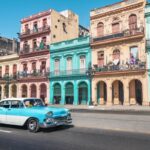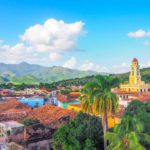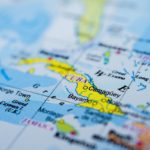Matanzas is one of the most exciting cities to visit in Cuba. It is the capital city of the province in Cuba with the same name. Known for Afro-Cuban folklore, culture, and poets, it is situated on the island’s northern shore and has plenty to offer visitors.
Where is Matanzas?
Matanzas is located approximately 50 miles to the east of Havana. The city was founded in 1693, despite the Spanish knowing about this excellent bay since 1508. Pirates actually used it!
By 1860, Matanzas had become Cuba’s second city. However, as the sugarcane industry expanded into the eastern part of the island, the growth halted.
Today, it is one of Cuba’s chief ports, handling mainly henequen fiber and sugar. It is also an industrial center, which manufactures matches, fertilizers, shoes, rope, and rayon.
It is a wonderful location with many historic buildings, scenic drives, monuments, and plazas.
If you are planning on visiting Matanzas, it is linked to Havana by two rail lines, as well as the Central Highway in Cuba.
The City of Bridges
Matanzas is fondly known as the City of Bridges, as there are 17 bridges in the area. These bridges cross three distinct rivers that travel through the city:
Because of this, it is also sometimes given the nickname of the Venice of Cuba.
Where dance was born
Matanzas is a place full of vibrancy and life. It is the birthplace of the dance and music traditions of rumba and danzon.
Cuban Rumba
Rumba is a secular Cuban music genre involving song, percussion, and dance. It originated mainly in Matanzas and urban Havana throughout the late 19th century. It focuses on African dance and music traditions, namely yuka and Abakua, and also coros de clave, which is Spanish-based.
Danzon
Danzon is the official musical dance and genre of Cuba. It is a formal, slow dance, which requires a partner.
What are the main attractions in Matanzas?
There are some incredible places to visit in Matanzas. Let’s take a look at them in further detail…
Quinta de Bellamar
The Villa of Bellamar, La Quinta de Bellamar, is one of the biggest homes in Matanzas. It lies on the Bay of Matanzas, which is just outside of the city itself in the neighborhood of Bellamar.
Construction on the property was during the 18th century. The Tamargo family bought the house at the turn of the 20th century, using it as their summer home.
The Tamargo family sold the house to the Catholic Church in 1956. This saw most of the property disappear.
The living room and the front facade are the only two parts of the original property that remain, with the living room being the actual church. The Quinta is so big that you can see it from across the bay.
Necropolis de San Carlos Borromeo
Also known as San Carlos Cemetery or Cementerio de San Carlos, Necropolis de San Carlos Borromeo is at 29MW+3PQ, Matanzas, Cuba.
It is considered the third most crucial Cemetery in Cuba in terms of the personalities interred, the architecture, and the patrimonial value.
Francisco Sosa Velez was the principal architect. He used cast iron, bronze, and Carrara marble for the construction.
Necropolis de San Carlos Borromeo was inaugurated on the 2nd of September in 1872 on 13.5 hectares. The octagonal Chapel contains the remains of the martyrs of different wars of independence.
It contains the only active catacombs on the island, which include 756 niches in a pair of underground pantheons and an exclusive ventilation system against atmospheric pollution.
Matanzas bridges
As mentioned in the introduction, there are many bridges for you to discover in Matanzas. There are many incredible bridges for you to explore, but one of the most significant has to be the Cross Puente de Bacunayagua Bridge.
This bridge represents the border between the provinces of Matanzas and Mayabeque. It is the highest and longest bridge in Cuba, measuring 103 m. in height and just over 314 m. in length. It is one of the wonders of civil engineering in Cuba.
Construction for this bridge started in 1957, and Fidel Castro inaugurated it in 1959. The views of this bridge and the lush Yumiri valley around it are undoubtedly photograph-worthy.
Catedral San Carlos De Borromeo
Otherwise known as Matanzas Cathedral, the Catedral San Carlos De Borromeo is an architectural beauty in Matanzas. It is in quite an isolated and serene spot on Calle Jovellanos street.
The Cathedral took many years to build, starting in 1693 and completing in 1736. There were then several refurbishments until it was finally a Cathedral in 1912. However, many people would agree that it was worth the wait.
Although some parts of the Cathedral are pretty run down, the beauty and magic of one of the most impressive and vital symbols of Cuban eclecticism from the 19th century. The distinct Baroque and Neoclassical elements are stunning.
In terms of the interior, you can view some of the most famous frescos in Cuba here, although they could be in better condition.
Sauto Theater
The Sauto Theater has been a proud symbol of the city since it opened in 1863. The 775-seat theater is U-shaped and almost entirely covered with paneling made from wood.
It is one of the most functional and elegant 19th-century Cuban theaters. There are three balconies, and they can raise the floor of the theater can, which converts the auditorium into a ballroom.
You will witness stunning Carrara marble statues of Greek goddesses in the lobby. The theater’s original curtain is a breathtaking painting of the Puente de la Concordia over the Yumurí River.
Once you’re in the main hall, make sure you look above, as there are incredible paintings of the muses on the ceiling.
Today, the theater is a sub-venue for vital global events held in the capital, such as Mayo Teatral and the International Ballet Festival.
Between 2010 and 2018, the theater was closed for renovations, but it is open again today, so it is certainly worth visiting while you are in Matanzas.
Museo Histórico Provincial de Matanzas
This is another must-visit while you are in Matanzas, Cuba. This museum is in Palacio de Junco. It is basically the physical headquarters of Matanzas’ entire history.
Don Vicente del Junco y Sardinas owned the property back in 1838. Then after being reconstructed, it became the Museo Histórico Provincial de Matanzas in 1980.
Before this, the museum was in operation but was moving from location to location. This is because the collections were so extensive that they would run out of space.
However, when Palacio de Junco became available, it was the perfect fit.
With three large floors, it finally became possible to exhibit all of the materials to the public. There are now 15 permanent exhibition rooms, another temporary room, and a cultural center for events.
This is an attraction we recommend everyone visit when in Matanzas, as it is the best place to learn about the entire history of the location. From the political struggles to the sugar industry, you will go on a journey of Matanzas throughout the years.
Pharmaceutical Museum
Last but not least, the Pharmaceutical Museum in Matanzas is another fascinating place, enabling you to find out about some of the most innovative medical advances in the 19th century.
You will find this museum in Calle Milanes, in front of La Libertad Park. This pharmacy museum is unique because you can observe the 19th-century French pharmacy exactly how it was at the time. It has National Monument status, ensuring preservation.
It is the world’s only preserved pharmacy of its kind!
We have Ernesto Triolet to thank for this pharmacy, which dates back to 1882.
In 1964, a museum was born in this building. Today, you can enjoy educational guided tours, which involve all elements of the pharmacy, from the lab to the sales room and back room. It is a truly fascinating and eye-opening museum.
There are even some preserved natural ingredients that were in use at the time. You can also look at well-kept medicine books from the 19th century, as well as thousands of glass and paper labels for medicine classification.
Enjoy a fantastic trip to Matanzas
As you can see, there is a lot to do in Matanzas, and personality is bursting from the seams! A place full of interesting attractions, incredible dance and music, and stunning scenery; you certainly won’t be disappointed when visiting this part of Cuba.
- The Art of Cuban Poster Design: History, Techniques, and Cultural Significance - May 23, 2023
- Taking A Vintage Car Tour In Havana - May 23, 2023
- Top 5 Cuban Revolutionary Sites - May 23, 2023








